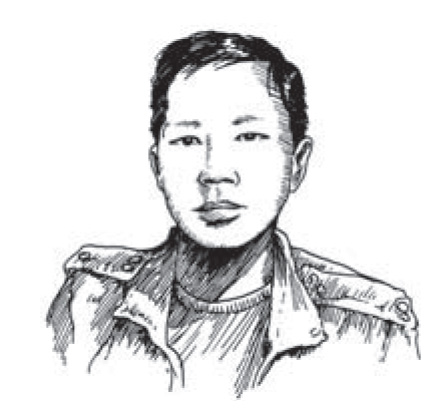The second time I meet Paul Chan at his Brooklyn studio, there’s a small earthquake. The couch we’re sitting on shakes. Chan gets up and looks around. People have left the large warehouse in New York where he works, and are standing on the streets. So we evacuate, wait, and, after nothing happens, go back indoors. On the way up to his studio, Chan offers a suggestion for this interview. “Say that I caused the earthquake,” he says. “We were talking about friendship, or men, and suddenly my eyes turned bright green and I started speaking Aramaic.”
This kind of joke is characteristic of Chan, who’s made himself known as a sort of art-world trickster. Born in Hong Kong, he moved to Omaha (“the birthplace of Malcolm X and also Ed Ruscha”) as a child partly because the Hong Kong air was making him sick. He attended the School of the Art Institute of Chicago and then Bard College, where he earned an MFA. Chan’s art treats political subjects in lyrical, often incongruous ways. In 2002, he traveled with an American aid group, Voice in the Wilderness, to Iraq, where he filmed Baghdad on the eve of the Iraq War—intimate scenes of cafés and interviews with the city’s residents. His collection of poetic shadow projections, The 7 Lights, premiered at the Serpentine Gallery in London in 2007, and he gained national prominence later that year for a staging of Waiting for Godot in post-Katrina New Orleans. His last exhibit, a nearly six-hour video projection entitled Sade for Sade’s Sake, was shown in 2009 at the Venice Biennale and at Greene Naftali Gallery in New York.
Recently, he’s turned his attention away from exhibitions and toward publishing books, starting one of the first, and certainly the most lewd, houses devoted solely to artistic e-books. Among the projects is a series of fonts Chan made in conjunction with his Sade exhibition that transform any piece of writing into a filthy text. He’s been applying the fonts to Plato and John Maynard Keynes.
We spoke twice in his three-room studio, eating almonds and stale sour candy.
—Madeleine Schwartz
I. CARROT
THE BELIEVER: How long have you been in this space?
PAUL CHAN: Two and a half years.
BLVR: It’s nice! It’s a nice area!
PC: There’s a Costco… and an IKEA. The only batting cages I’ve ever seen are five blocks away. I went once with Cory [Arcangel, another artist, who works downstairs]. It was fun. And I will probably never go again. I actually don’t like baseball. I don’t know why I went.
BLVR: That’s very un-American.
PC: One thing I don’t like about...
You have reached your article limit
Sign up for a digital subscription and continue reading all new issues, plus our entire archives, for just $1.50/month.
Already a subscriber? Sign in





